
|   |

|   |
The fountain was flowing - Sandhya Shankar e-mail: sandhyashankaris@gmail.com Photos courtesy: Bharatakalanjali April 17, 2022 I must say I was looking forward to the second weekend of Jharna, the festival of dance, music and more. The first to perform was Shruthi Rao from Bangalore who was an alumnus of Kalakshetra and currently mentoring under Guru Padmini Ravi. Her performance explored the questions from the eyes of Kumara Vyasa, author of the Kumara Vyasa Bharata. It is said that this version of the Mahabharata is one of the masterpieces in the world of Kannada literature. For those who are not familiar with Kannada literature, Kumara Vyasa whose original name was Narayanappa, was an influential and classical Vaishnava poet of early 15th century in Kannada. His pen name Kumara Vyasa is a tribute to his magnum opus, a rendering of the Mahabharata in Kannada. Kumara Vyasa literally means "Little Vyasa" or "Son of Vyasa" We all know that Vyasa is the title of Krishna Dwaipayana, the author of Mahabharata. He was the contemporary and archrival of the famous Veerashaiva poet laureate Chamarasa who wrote the seminal work Prabhulingaleele covering the lives of Allama Prabhu and other Shiva Sharanas, circa 1435. Both poets worked in the court of Deva Raya II. 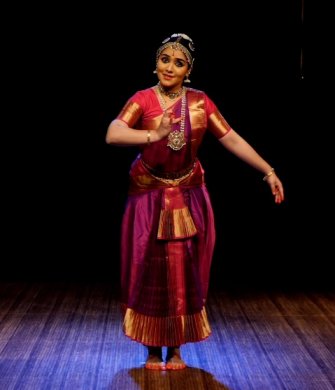 Shruthi Rao Kumara Vyasa's most famous work, the Karnataka Bharata Kathamanjari (the Mahabharata of Karnataka) is popularly known as Gadugina Bharata and Kumara Vyasa Bharata. It is an adaptation of the first ten parvas (chapters) of the Mahabharata. A devotee of Krishna, Kumara Vyasa ends his epic with the coronation of Yudhishthira, the eldest of the Pandavas. The work is celebrated in Kannada literature due to its universal appeal. In Gadugina Bharata, Kumara Vyasa explores a wide range of human emotions, examines values, and displays extensive mastery over vocabulary. The work is particularly known for its use of sophisticated metaphors. Kumara Vyasa is also renowned for his characterizations. Karnataka Kathamanjari is also known as Dasha Parva Bharata because it originally had only ten parvas as opposed to the eighteen in the original Mahabharata. This literature is explored in the gamaka tradition which is a form of storytelling where the singer sings the verses and there is a vachanakara who delves into the nuances and explains it to the audience. Shruthi chose 4 verses from the Sabha Parva. Her dance was interesting and a good representation of the poet's work. Knowing the language helped me connect with the performance and Shruthi brought life into the poetry. There were 2 performances everyday, with a 15-minute break between them, and I am sure no one wanted to leave halfway. The next performance by Indu Santosh exceeded my expectations in all aspects, creativity, concept, technique, and stage presence. Let us first take the concept or theme chosen by Indu, which was a character from the Ramayana. Most people know the story which could well be the greatest blockbuster of all times, having innumerable characters, heroes, superheroes, villains, super villain, his henchmen, comedians, heroines, female seductress and an uncountable range of emotions... jealousy, greed, dutifulness, devotion, anger, obsession, compassion, trust, distrust, patience, impatience, endurance, despair, teamwork, justice and everything that you can think of! The multiple characters are not only interesting, but they have an individuality... and this has always fascinated me and generations after generations making it a timeless treasure. One can use it as a study material to understand psychological needs or problems of people. If the earlier week we had Devika in the character of Lakshmana's wife Urmila, this week we had Indu as the monkey king Vali's wife Tara. Where else will you see importance being given to the story of Tara, a monkey queen...who would care for a monkey's narrative.... that is where our epics are unique. This presentation is taken from the Valmiki Ramayana, Malayalam Padam by Sadanam Harikumar, Sanskrit verses by Arjun Bharadwaj and Mahesha Swami. 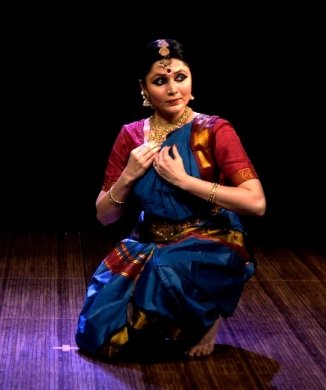 Indu Santosh Tara is extolled as one of the Panchakanyas, where it is said that merely remembering her name daily, will remove all sins. She is a spiritually evolved character, and an epitome of wisdom and foresight...despite all of these virtues, she came with her baggage of emotional conflicts. While she loved Vali, she did not approve of his uncontrollable anger and impulsive nature, as well as his actions of exiling Sugriva and kidnapping Sugriva's wife, Ruma. But her advice to Vali went unheeded and her foresight warned him about the consequences of the duel fight against Sugriva, which in turn gets Vali killed. Like any other living being, losing her mate is not easy to cope for her. Looking from her perspective Tara faces some of the most challenging situations in life but she converts them into opportunities and makes some wise decisions. Now, not only was the narrative appealing to me, but Indu's performance left me awestruck. Her movements, expressions, agility were altogether mesmerising. The whole performance was thought provoking - how and what is it that made two loving brothers Vali and Sugriva into sworn enemies? Was it power, lust, insecurity, inferiority or maybe superiority complexes, distrust, sibling rivalry or destiny that changed their relationship leading to the younger brother to partner with Rama and conspire the elder brother's death? For Sugriva, was Ruma more important than his brother? Wouldn't it have been proper for his Lord Srirama to have a dialogue, try and unite the brothers and broker peace? After all, who better than Rama to speak of brotherly love when he has experienced that with his own brothers? Why did Sugriva have no confidence in the strength of his brother and assumed that Vali had died in the hands of the demon Mayavi? Why was Sugriva impatient to sit on the throne, a total contrast to Bharata's devotion to his brother? Why didn't Vali kill Sugriva as a punishment instead of banishing him and giving him an opportunity to regroup and ally with Rama, which ultimately led to Vali's death at the hands of Rama. So many questions, so many layers in this great story all brought out in the most tangible and beautiful way by Indu. She must have made her teacher Shobana Bhalchandra very proud. On day 5, the evening opened up to something different and delightful. It was Tholbommalatam or leather puppetry by Seethalakshmi. No surprises, it was Ramayana again! It is not an exaggeration that whether it is Ramayana or Mahabharata, it is never ever boring. So many dimensions, so many artistic ways to reach it to people, so many characters. This was the first time I was witnessing a Tholbommalatam live. It is a unique art and Seethalakshmi and her team (which is mostly her family) need to be thanked to have kept this art alive. Leather puppets are the hallmark of art and craft of Andhra Pradesh. Intimately linked to the state's unique traditional folk and cultural expression, also known as 'Tholu Bommalata' (dance of leather dolls), one of the oldest surviving shadow puppet theatres in the world, fashioned of translucent coloured leather, projected on a small screen. 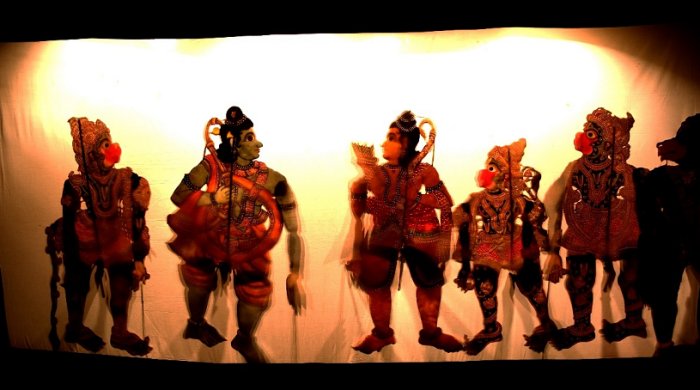 Tholbommalatam As soon as lights go off, a loud voice, along with classical music, booms, and different characters leap onto the white screen. Deeply connected with spiritual beliefs and cultural practices, this shadow puppetry mainly depicts narratives from epics like the Mahabharata and Ramayana, blending them with local customs, social issues and passing culture from one generation to another to keep this form alive. Leather puppets are made from goatskin that is transformed into a translucent parchment through an arduous process of washing and cleaning. After it is completely clean, the hide is marked out with the outlines of the figures of the puppets, punching holes in-between, as the numerous little windows create a sparkling effect when held against light, adding to the beauty and attraction of the show. The outlines are then marked with black ink using a bamboo nib. After this, the leather is coloured in vibrant hues such as red, green, yellow, and more. To make the puppets, individual parts or organs of the puppet like legs, arms or head, are cut and then stitched together. The puppet is then mounted on sticks and bound with ropes to facilitate free movement. An average puppet takes up to four days to complete and a considerable amount of talent as well. It was a beautiful and quaint play of these leather puppets, and I was thankful to Jharna to have included this in the program flow. The world needs to know about Seethalakshmi who has strived to keep this art alive. 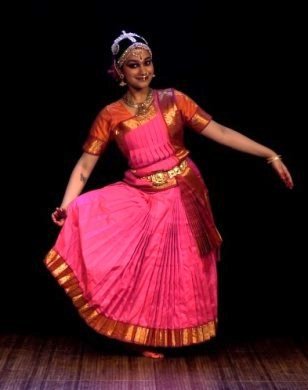 Satvika Satish The second program for the day was Bharatanatyam by young Satvika Satish, a student of Shobana Bhalchandra. Satvika chose a traditional performance that day, beginning with her attire, and choice of themes. Her first choice was a Devi Krithi "Thaaye Tripurasundari" in ragam Shuddha Saaveri set to khanda chapu talam, a composition of Periyasami Thooran. With a good start, she went on to perform a Jayadeva ashtapadi "Chandana charchita" in ragam Yamuna Kalyani set to adi talam. I have often felt that any ashtapadi is so very beautiful that it takes care of half the responsibility of the outcome. But the other half depends on the artiste, vocalist or dancer. Satvika is probably a little young to bring out the erotic poetic beauty of an ashtapadi as Jayadeva would have expected or an admirer of Jayadeva's brilliance would have imagined. Just perfect technique is not enough to explore the richness of ashtapadi. In her next creative piece where it required exploring Pancha Bhutas through geometrical patterns in movement, she was much better. She ended the day with a Thillana in ragam Rageshree, set to adi talam composed by the one and only Lalgudi Jayaraman. 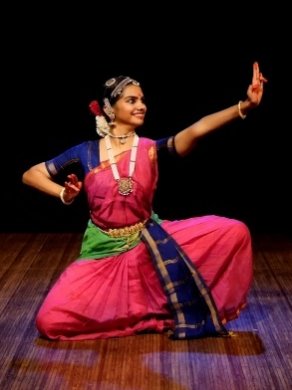 Shyama Balachandran The 6th day of the festival had an eager audience since Jharna had begun in a grand way. One of the heartening things was that Jharna brought together good amount of talent from other cities. The first artiste for the evening was Shyama Balachandran from Mumbai. Watching her, it was evident that being a holistic Bharatanatyam artiste, she is persistent in delving deeper in the art form. Shyama began her performance with a traditional Alarippu in the marga tala Chaachaputa of 26 aksharas. This Alarippu was composed by Guru Bharadwaj and choreographed by Shobana Bhalchandra as a part of Guru GV Ramani Natya Kala Foundation's revival of marga tala project. Shyama's next 2 presentations were compositions from her solo production Tuka, choreographed under the mentorship of Gayatri Subramanian. Her tall personality with her Maharashtrian nose pin and 1000-watt smile were add-ons for the pleasing performance. Personally, I took time to adjust to Abhangs and Bharatanatyam coming together. But guess that is where creative license steps in. After all today, almost every Carnatic vocal concert is having an Abhang. In her own words, about her journey with the Abhangs of Tukaram elucidating various emotions, "What comes into our mind when we first hear the word 'saint'? A man with a long beard and droopy eyes, talking about things that seem irrelevant to us, isn't it? But Tukaram, a 16th century Varkari saint poet, was nothing like that. In his compositions, one witnesses everything from love, passion, and devotion to disdain, amusement and even laughter. We see him as a seer, a lover, a devotee, a storyteller and even as a social reformer. A gruhasta, who evolved and chose the path of the divine." The last program for the Jharna festival was a contrast from what we had seen for two weekends. It was Indie music. I suddenly saw a different audience profile altogether. There were so many youngsters, probably school going or college students who came in groups, to listen to Indie music. Remember, what a big hit the songs from Farhan Akhtar's 'Rock On' were? I remember audience singing along when Farhan sang 'Meri laundry me bill' (those were the days before OTT when we went to theatres). Well, it wasn't very different with Krsna's singing. What worked is the way he connected with the audience giving anecdotes from his childhood, about his own birthday, his grandmother (who incidentally was there in the audience, absolutely cute and looking adoringly at her grandson). 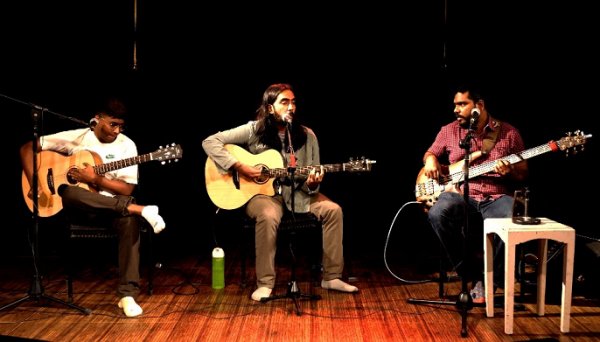 Indie music by Krsna Like the first song was about online schooling and aren't we all so much aware of that during pandemic. The songs being largely in Tamil or Tanglish were appealing to almost everyone there. Who among us, have not had a Paati and if the Paati makes dosas...it is not a mere hot pancake made from some batter but it is oodles of love served on your plate! Songs which narrated his own birthday excitement or lack of it! Krishna knew what the audience wanted like when he sang about his Hindi, Tamil and English teachers in a trilingual manner there was a lot of cheering. The best way for this kind of music to work is in getting the audience involved. His songs were about power cut, Mark Zuckerberg... When Krsna's songs are mostly about himself, how can he not mention his mother, so there it is about his mother and his room being cleaned. All of these were just in bits and pieces, none were complete songs. Except when he chose to sing about an existential question that was a full song. He was natural with a nice voice, simple appealing lyrics but after a point, anyone with a trained ear like me, realises that all the songs sound the same.... Whether it was about college culturals or his grandmother's dosas. Jharna ended on a happy note and we look forward to more such festivals. 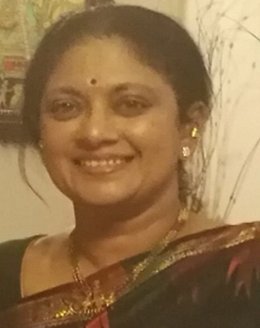 Sandhya Shankar belongs to a respected business family in Chennai. She is a Life Skills & Corporate Trainer by profession. An avid reader, she has written several poems and articles. She has keen interest in all art forms and has explored many different forms of painting like stained glass and Tanjore being among them. She is a trained musician. Her witty reviews have gained a loyal and interactive readership. |